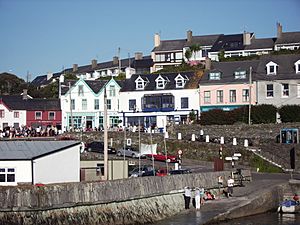Baltimore, County Cork facts for kids
Quick facts for kids
Baltimore
Dún na Séad
|
|
|---|---|
|
Village
|
|

Baltimore in 2005
|
|
| Country | Ireland |
| Province | Munster |
| County | Cork |
| Barony | Carbery West |
| Civil parish | Tullagh |
| Founded | 1607 |
| Elevation | 26 m (85 ft) |
| Population
(2022)
|
414 |
| Eircode (Routing Key) |
P81
|
| Area code(s) | 028 |
| Irish Grid Reference | W051264 |
Baltimore is a small village in western County Cork, Ireland. It's the main village in the Rathmore and the Islands parish, which is the southernmost parish in Ireland. Baltimore is also the main ferry port for nearby Sherkin Island, Cape Clear Island, and other islands in Roaring Water Bay.
The name Baltimore comes from the Irish words Baile an Tí Mhóir, meaning "town of the big house". However, the Irish name for Baltimore is Dún na Séad, which means "Fort of the Jewels". This name comes from the O'Driscoll family's castle, Dún na Séad, which has been restored and overlooks the village. In ancient times, Dunashad was seen as a special place for druids. It is also linked to the Irish festival of Bealtaine.
Contents
History of Baltimore
Ancient Times and Early Settlements
Baltimore was once home to the Corcu Loígde, an ancient Irish family. They were powerful kings in Tara and Munster. You can still find signs of old settlements here. These include ring forts (circular earthworks), fulacht fiadh (ancient cooking sites), and souterrains (underground passages). Dunasead Castle, also known as Baltimore Castle, has been a fortified site since at least the early 1200s.
Medieval Mentions and English Colony
Baltimore is mentioned in old writings from the 1400s. One story from 1413 tells how the Mayor of Waterford visited the O'Driscoll family at Dunasead. He was invited for Christmas but then took the O'Driscolls as prisoners back to Waterford.
Around 1605, an English settlement was started in Baltimore by Sir Thomas Crooke, 1st Baronet. King James I of England supported this. Crooke rented the land from Sir Fineen O'Driscoll, who was the leader of the O'Driscoll family.
Baltimore became a busy place for fishing, especially for pilchards. In the early 1600s, it was also a base for pirates. Many people in the town were involved in these pirate activities. In 1607, Baltimore became a market town. This meant it could hold a weekly market and two yearly fairs.
The Sack of Baltimore
A very important event in Baltimore's history happened in 1631. The village was attacked in what is known as the Sack of Baltimore. Barbary pirates from North Africa raided the town. They captured between 100 and 237 English settlers and local Irish people. These people were taken away and sold into slavery far from Ireland. Only a few ever returned.
After this attack, many survivors left Baltimore and moved to Skibbereen. The village was almost empty for many years. It slowly began to recover in the 1700s and started to grow again in the early 1800s. However, it suffered more hardship during the Great Famine.
In 1612, Baltimore was given special "borough" status. This meant it had its own local government. It also sent two members to the Irish Parliament until 1801.
Places to Visit
One of the most famous sights in Baltimore is the Baltimore Beacon. It's also known as Lot's wife. This tall, white structure stands on the eastern side of the harbour entrance.
The original beacon was built by local people. But in 1847, it was found to be too small and damaged. So, a new, stronger beacon was planned. After getting permission from Lady Carbery, who owned the land, construction began.
By February 1849, the stone part of the beacon was finished. The Baltimore Beacon is about 15.2 meters (50 feet) tall. It is shaped like a cone and painted white. It's a very important landmark for sailors and fishermen.
Things to Do in Baltimore
Baltimore is a popular place for visitors, especially in the summer. Many people have summer homes here, so the population grows. It's a great spot for those who enjoy sailing, fishing, and exploring the beautiful countryside.
You can use Baltimore as a starting point to visit nearby islands like Cape Clear and Sherkin. Another interesting place to explore is Lough Hyne. This is Ireland's first marine nature reserve and is about 5 kilometers from the village. It's a unique saltwater lake connected to the sea.
Baltimore is also a popular place for scuba diving. This is because there are many different shipwrecks in the bay. These include a Second World War submarine (U-260), a large cargo ship called the Kowloon Bridge, and the Alondra from 1916.
Sports and Activities
Baltimore has a local Gaelic Athletic Association (GAA) club called Ilen Rovers. It was formed in 1973 and includes players from the surrounding areas. They play in the Cork County Senior Football Championship.
The local soccer team is Baltimore FC, also known as the Crabs. They started in 2006 and play in the West Cork League.
Sailing is also very popular in Baltimore. During the summer months, you can find sailing courses for both kids and adults.
Getting Around
Ferries regularly sail from Baltimore to Schull along the coast. They also go to Sherkin Island and the more distant Cape Clear Island.
Baltimore is located on the R595 road. This road connects to the N71 road, which leads to Cork City. Cork is about 100 kilometers away. The closest town to Baltimore is Skibbereen, which is about 13.4 kilometers northeast. Bus services connect Baltimore to Skibbereen and Cork. The nearest airport is Cork Airport.
Baltimore used to have a railway station. The Baltimore railway station opened in 1893 but closed in 1961.
See also
 In Spanish: Baltimore (condado de Cork) para niños
In Spanish: Baltimore (condado de Cork) para niños


